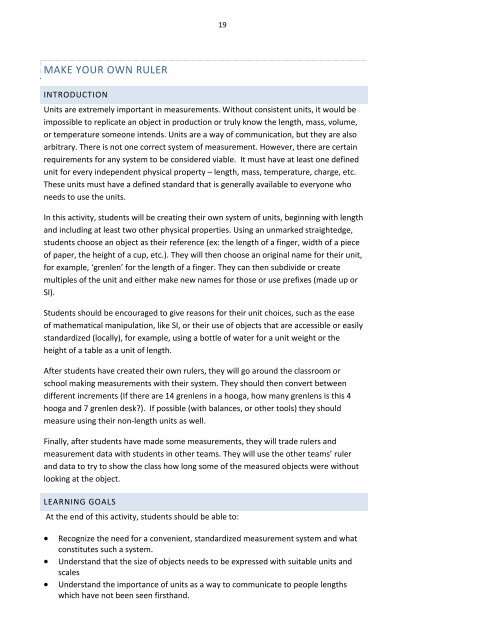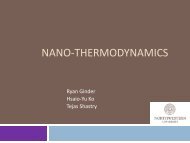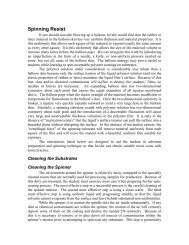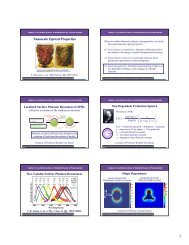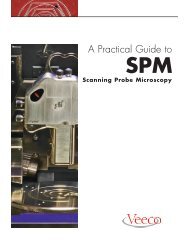MAKE YOUR OWN RULER
MAKE YOUR OWN RULER
MAKE YOUR OWN RULER
Create successful ePaper yourself
Turn your PDF publications into a flip-book with our unique Google optimized e-Paper software.
19<br />
<strong>MAKE</strong> <strong>YOUR</strong> <strong>OWN</strong> <strong>RULER</strong><br />
INTRODUCTION<br />
Units are extremely important in measurements. Without consistent units, it would be<br />
impossible to replicate an object in production or truly know the length, mass, volume,<br />
or temperature someone intends. Units are a way of communication, but they are also<br />
arbitrary. There is not one correct system of measurement. However, there are certain<br />
requirements for any system to be considered viable. It must have at least one defined<br />
unit for every independent physical property – length, mass, temperature, charge, etc.<br />
These units must have a defined standard that is generally available to everyone who<br />
needs to use the units.<br />
In this activity, students will be creating their own system of units, beginning with length<br />
and including at least two other physical properties. Using an unmarked straightedge,<br />
students choose an object as their reference (ex: the length of a finger, width of a piece<br />
of paper, the height of a cup, etc.). They will then choose an original name for their unit,<br />
for example, ‘grenlen’ for the length of a finger. They can then subdivide or create<br />
multiples of the unit and either make new names for those or use prefixes (made up or<br />
SI).<br />
Students should be encouraged to give reasons for their unit choices, such as the ease<br />
of mathematical manipulation, like SI, or their use of objects that are accessible or easily<br />
standardized (locally), for example, using a bottle of water for a unit weight or the<br />
height of a table as a unit of length.<br />
After students have created their own rulers, they will go around the classroom or<br />
school making measurements with their system. They should then convert between<br />
different increments (If there are 14 grenlens in a hooga, how many grenlens is this 4<br />
hooga and 7 grenlen desk?). If possible (with balances, or other tools) they should<br />
measure using their non‐length units as well.<br />
Finally, after students have made some measurements, they will trade rulers and<br />
measurement data with students in other teams. They will use the other teams’ ruler<br />
and data to try to show the class how long some of the measured objects were without<br />
looking at the object.<br />
LEARNING GOALS<br />
At the end of this activity, students should be able to:<br />
• Recognize the need for a convenient, standardized measurement system and what<br />
constitutes such a system.<br />
• Understand that the size of objects needs to be expressed with suitable units and<br />
scales<br />
• Understand the importance of units as a way to communicate to people lengths<br />
which have not been seen firsthand.
20<br />
MATERIALS<br />
• A ruler<br />
• A reference unit (ex: length of a finger, width of a piece of paper, height of a cup,<br />
etc.)<br />
• 5 objects for measurement. Some examples:<br />
o Length of a cell phone<br />
o Width of a pencil<br />
o Size of the tip of a pencil<br />
o Circumference of a basketball<br />
o Length of the teacher’s left foot<br />
• Long piece of paper (calculator paper)<br />
• Scissors<br />
PROCEDURE<br />
PART ONE<br />
1. Split the students into groups of 3 or 4<br />
2. Have a student obtain a ruler<br />
3. The students will now create their own reference unit. This unit can be based on<br />
anything. The only condition is that the units cannot be based on units that already<br />
exist like meters or inches.<br />
4. Encourage them to come up an original name for the unit as a group. Have the<br />
students measure the reference unit with the ruler and mark this length of the piece<br />
of paper.<br />
5. Have them use the ruler to make repeats of the unit.<br />
6. Using scissors cut out the entire length of the reference unit with its repeats.<br />
Repeated units can have new names (ex: 12 inches = 1 foot, 3 legers = 1 widget)<br />
7. Subdivide the units and come up with a new name for the smaller units<br />
8. Have groups define two other units that relate to different physical properties.<br />
9. Measure the 5 objects with the new ruler. Record the lengths on the worksheet<br />
with units<br />
PART TWO<br />
1. After the students have recorded the lengths onto the worksheet, exchange<br />
worksheets with another group in the classroom.<br />
2. Using the ruler and data given, the other group will try to show, with their hands,<br />
arms, or by standing apart from one another, how long some of the measured<br />
lengths were.<br />
3. The ruler’s original group will verify their findings.
21<br />
<strong>MAKE</strong> <strong>YOUR</strong> <strong>OWN</strong> <strong>RULER</strong> WORKSHEET<br />
Reference Unit:<br />
Length of reference unit<br />
Names of Multiples and/or subdivisions (ex: 5 posts = 1 leger, 3 legers = 1 widget)<br />
Object<br />
Measurement – Numbers and<br />
Units<br />
Express two of your larger objects as using your smaller unit. For example, in the metric<br />
system, an object that is measured 3 meters and 25 centimeters is 325 centimeters<br />
long.<br />
Express two of your smaller objects using your larger unit. For example, a pencil that is 5<br />
inches long is 0.417 feet long.
22<br />
DISCUSSION QUESTIONS<br />
PART ONE<br />
Ask the class how long one of the objects they measured was. Compare one group’s<br />
system of measurement with another group’s. What differences can be seen?<br />
Pair the groups and ask one group to look at another group’s measurement data. Can<br />
they guess what the reference unit is?<br />
Have each pairing try to come up with conversions factors between the groups. For<br />
example, if one group said the door was 16 legers, and another group said the door was<br />
20 knuts, then the conversions factor is 16 legers/20 knuts or 4 legers/5 knuts.<br />
Have each group explain their choice of units to the class.<br />
PART TWO<br />
Why were you able to find the length of something using someone’s ruler which you<br />
had never seen before?<br />
The units were standardized between the two people, and so they could effectively<br />
communicate with each other.<br />
If two people were building different parts of a machine on opposite sides of the world,<br />
why are they able to make pieces that fit together perfectly?<br />
They share a common system of units, and can communicate the required or provided lengths<br />
to each other.


